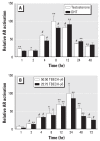Diastereomers of the brominated flame retardant 1,2-dibromo-4-(1,2 dibromoethyl)cyclohexane induce androgen receptor activation in the hepg2 hepatocellular carcinoma cell line and the lncap prostate cancer cell line
- PMID: 20049203
- PMCID: PMC2799458
- DOI: 10.1289/ehp.0901065
Diastereomers of the brominated flame retardant 1,2-dibromo-4-(1,2 dibromoethyl)cyclohexane induce androgen receptor activation in the hepg2 hepatocellular carcinoma cell line and the lncap prostate cancer cell line
Abstract
Background: Reported incidences of prostate cancer and masculinization of animals indicate a release of compounds with androgenic properties into the environment. Large numbers of environmental pollutants have been screened to identify such compounds; however, not until recently was 1,2-dibromo-4-(1,2-dibromoethyl)cyclohexane (TBECH) identified as the first potent activator of the human androgen receptor (hAR). TBECH has been found in beluga whales and bird eggs and has also been found to be maternally transferred in zebrafish.
Objectives: In the present study we investigated interaction energies between TBECH diastereomers (alpha, beta, gamma, and delta) and the hAR, and their ability to activate the receptor and induce prostate-specific antigen (PSA) expression in vitro.
Methods: We performed computational modeling to determine interaction energies between the ligand and the AR ligand-binding site, and measured in vitro competitive binding assays for AR by polarization fluorometry analysis. We used enzyme-linked immunosorbent assays to determine PSA activity in LNCaP and HepG2 cells.
Results: We found the gamma and delta diastereomers to be more potent activators of hAR than the alpha and beta diastereomers, which was confirmed in receptor binding studies. All TBECH diastereomers induced PSA expression in LNCaP cells even though the AR present in these cells is mutated (T877A). Modeling studies of LNCaP AR revealed that TBECH diastereomers bound to the receptor with a closer distance to the key amino acids in the ligand-binding domain, indicating stronger binding to the mutated receptor.
Conclusions: The present study demonstrates the ability of TBECH to activate the hAR, indicating that it is a potential endocrine disruptor.
Keywords: androgen; brominated flame retardant; endocrine disruptor.
Figures






References
-
- Araki N, Ohno K, Nakai M, Takeyoshi M, Iida M. Screening for androgen receptor activities in 253 industrial chemicals by in vitro reporter gene assays using AR-EcoScreen cells. Toxicol In Vitro. 2005;19(6):831–842. - PubMed
-
- Arsenault G, Lough A, Marvin C, McAlees A, McCrindle R, MacInnis G, et al. Structure characterization and thermal stabilities of the isomers of the brominated flame retardant 1,2-dibromo-4-(1,2-dibromoethyl)cyclohexane. Chemosphere. 2008;72(8):1163–1170. - PubMed
-
- Berry SJ, Coffey DS, Walsh PC, Ewing LL. The development of human benign prostatic hyperplasia with age. J Urol. 1984;132(3):474–479. - PubMed
Publication types
MeSH terms
Substances
LinkOut - more resources
Full Text Sources
Research Materials
Miscellaneous

